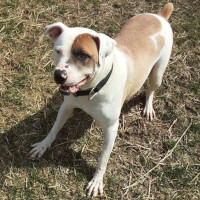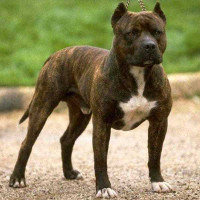Appearance of the Pyrenees Pit
|
| This crossbreed is generally a large animal that is very slightly longer than it is tall, although Pyrenees Pits are generally a little smaller than their parent breed, the Pyrenean Mountain Dog. They are well muscled and broad, with broad, robust heads and wide, deep muzzles. Those who lean towards the Pit Bull will generally have a stockier build, shorter muzzles and broader heads than those who more closely resemble the Pyrenean Mountain Dog. Their eyes generally come in shades of dark brown and can be round or almond-shaped, and they have short, somewhat triangular ears that can be carried low and close to the skull like the Pyrenean Mountain Dog or carried high in a rose or half, prick configuration like the American Pit Bull. The coat of the Pyrenees Pit can vary considerably from dog to dog, as the coats of the parent breeds are very different from one another. Some dogs may prefer the American Pit Bull Terrier heritage, with a short, single-layered coat, while others may inherit the winter-ready double-layered coat of the Pyrenees Mountain Dog, made up of a soft, thick undercoat covered by a layer of long, thick hair - a coarser texture. |
Temperament of the Pyrenees Pit
|
| Although this hybrid is generally affectionate and extremely loyal to its family or charges, it can be more aloof or wary of others and require more socialization than average to be comfortable in a variety of situations. Although these dogs are generally good with the children of their own family, they may inherit a tendency to be overzealous in protecting them from perceived threats. All interactions between these powerful animals and children or other pets should be closely supervised, especially if the animal or child is not well known to the dog. Both parent breeds of the Pyrenees Pit have been bred to be strong-willed, with the ability to think independently when needed. While these are useful traits for protecting sheep from large predators as Pyrenees Mountain Dogs are built to do, or for driving bulls to market like the Pit Bull's ancestors, they can make obedience training much more difficult. The best results can be achieved with early training focused on consistency and positive reinforcement. |
Needs and activities of the Pyrenees Pit
|
| Although these dogs are quite large and often have copious muscles, they don't require as much exercise as many other breeds with similar athleticism. An hour or two a day of moderate to vigorous exercise is usually enough to keep this hybrid healthy and fit. It may be advisable not to exercise your dog during the hottest part of the day in hot weather, as dogs with short, light-colored coats may be more prone to sunburn and skin cancer, while dogs with thicker, double-layered coats may be more susceptible to overheating. The Pyrenees Pit requires more space than most apartments can provide, and is happiest when given a larger home to spread out in. |
Maintenance of the Pyrenees Pit
|
| The Pyrenees Pit needs only occasional baths, as the coats of the Pit Bull and Pyrenean Mountain Dog tend to shed dirt naturally. The brushing requirements of this dog vary somewhat according to the coat it inherits. Those who inherit the double coat of the Pyrenean Mountain Dog, whatever its length, do not need to be brushed daily as this often leads to breaking of the hair tips, but they do require combing and brushing every two or three days. to avoid the formation of tangles or knots and to remove dead hairs from the coat. Those who inherit the Pit Bull's short, single-layered coat will often be able to keep it healthy and shiny with weekly grooming sessions using either a smoother brush or a grooming glove. |









 English (United Kingdom)
English (United Kingdom)